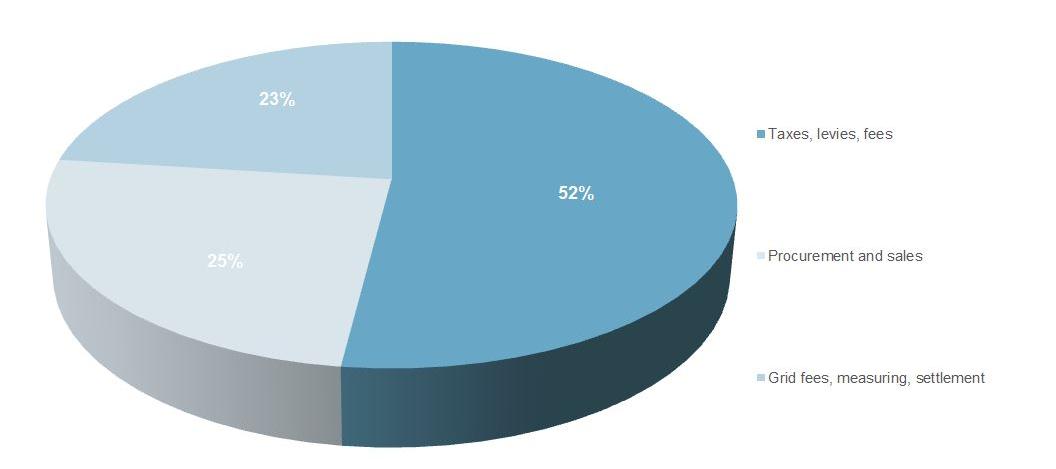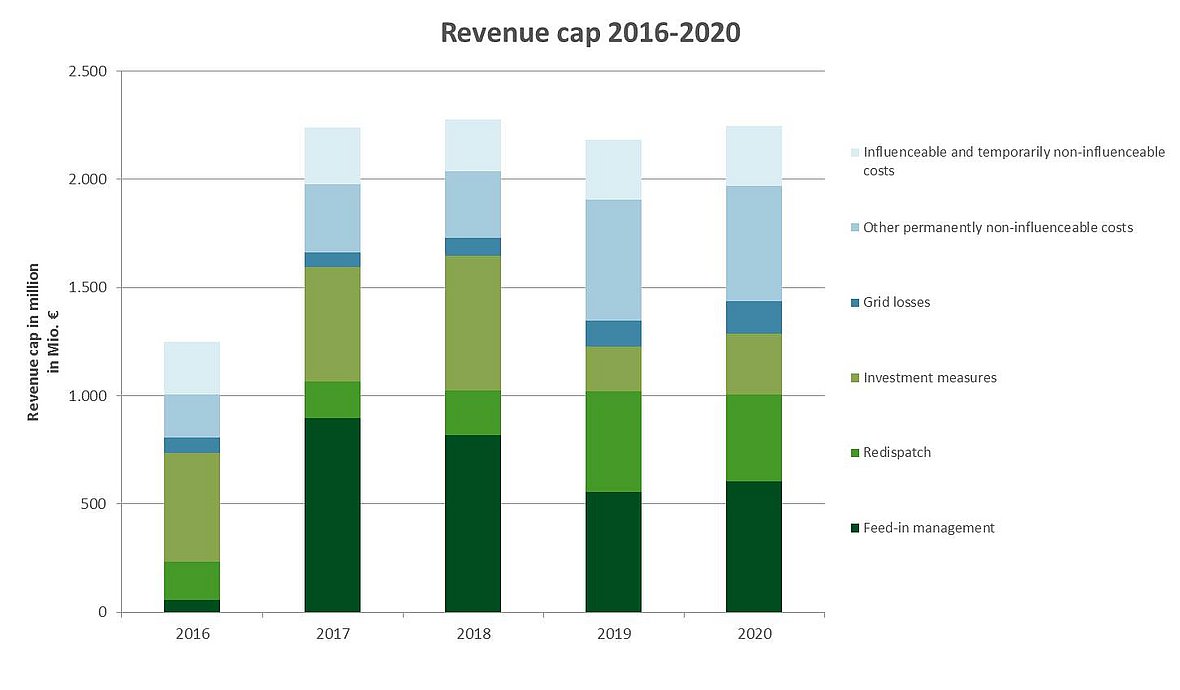The energy sector is developing rapidly. The process of European market integration began some years ago. Its purpose is to create a single European market that enables market parties to trade gas and electricity across national borders easily and efficiently.
E-Insights
Our vision is to be one of the most transparent Transmission System Operators (TSO) in Europe and thereby creating value for society. In this Energy Insights section we present selected energy related topics and show data, information and valuable insights.

German Regulation
How much of an average household's energy bill consists of the tariffs of the high-voltage grid? How are the tariffs that TenneT may charge its customers determined?
Regulation
In Germany transmission system operators are subject to incentive regulation as a regulatory system. This regulates the permissible revenue of a grid operator from grid fees and is intended to incentivise transmission system operators to become more efficient and lower their costs.
On this page, we explain how the incentive regulation works and how the permissible revenues are translated by TenneT into grid fees that end customers see on their bill as part of their electricity price. We also explain the role of the BNetzA as a regulatory authority.
Grid operators levy a grid charge for the transmission of electricity through their grids. As transmission system operators, TenneT's customers are not only directly connected companies or generation plants but also the subordinate grid operators - the distribution system operators. TenneT charges them for the use of the high and extra-high voltage grid. The underlying grid operators pass on the costs as part of their own grid charges to their customers. The end customer then sees the grid charge on his electricity bill, where the grid charges account for approx. 25% of the total price. Assuming an average electricity price of approx. 31.37 ct/kwh (source: BDEW Strompreisanalyse 2020), the network charges thus amount to approx. 7.71 ct/kwh. TenneT charges grid fees of an average of 2.109 ct/kWh, which represents a total share of the electricity price of approx. 6.72%. However, electricity prices vary due to the diverse supplier structure and regional differences.
All end customers who purchase electricity pay a price for this to their supplier. This electricity price consists of various components. These include taxes (such as the electricity tax), levies (such as the Renewable Energy Act (EEG) levy , which helps fund the expansion of renewable energies), costs for generation and distribution and grid fees.
- Grid fees are approx. 25% of the total electricity price
- Of which TSO grid fees (TenneT): approx. 6.7%
- Of which DSO grid fees: approx. 18.3%
- The electricity price is on average 31.37 ct/kWh,, of which approx. 7.71 ct/kWh consists of grid fees
- TenneT's grid fees are on average 2.109 ct/kWh, which leads to a total share of approx. 6.7%
From annual costs to grid fees
Among other factors, the grid fees that TenneT collects from its connected electricity customers are derived from the annual costs, in other words the total costs for reliable operation and expansion of the grid. To determine the grid fees, these annual costs are distributed across the extra-high voltage and transformation grid levels operated by TenneT. They are additionally divided between power and energy prices, depending on the size of the consumer. The amount of the power price is based on the quarter hour with the highest load in the respective calendar year, while the energy price corresponds to the total amount of electricity used. Depending on the consumer behaviour, the grid customer (in other words, the distribution system operator or large customer) pays either a low power price and a high energy price or a high power price and a correspondingly lower energy price. The grid fee calculation is also carried out in the year ahead of the one for which the prices apply.
Our grid fees can also be found on the published price sheets (link).
Standardisation of the grid fees
Germany is divided into four grid areas. TenneT is responsible for one of these grid areas. The four grid areas into which Germany is divided These grid areas have very different geographical conditions. For example, a great many wind turbines are located in northern and eastern Germany, partly in the grid region of TenneT, due to the good wind conditions. If these have to be switched off, for example due to congestion in the electricity grid TenneT is legally bound compensate the operators of the wind farms, which results in higher grid fees at TenneT. Transmission system operators that are hardly ever required to curtail wind turbines in their grid region are not faced with this challenge and have correspondingly lower grid fees. In other words, the burden on end customers is uneven for geographic reasons.
Due to the general responsibility of society as a whole for the success of the energy transition, the financial contribution should be the same across all regions of the country. For this reason, the grid fees of the transmission system operators will be standardised in stages over a period of five years starting in 2019. During this time, the grid fee will consist of a portion that is specific to a transmission system operator and a portion that is identical across the country. At the end of the five-year standardisation phase, the price for the end customers will be the same for all transmission grid operators and therefore in all regions.
Revenue cap (EO)
The revenue cap established by the BNetzA represents the upper limit of the permissible revenue that TenneT may generate in a five-year regulatory period. In other words, it sets the budget that TenneT must adhere to in its core business for the following five years. If TenneT succeeds in lowering its costs below the permissible revenue during this period, the company can make a profit. This mechanism serves to ensure that grid operators operate cost efficiently. The incentive-based regulation contrasts here with cost-oriented regulation, in which the grid operator is permitted to simply pass on the costs for its systems to the grid customers, thereby incentivising it to invest in particularly expensive systems, which is not in the interests of the grid customers.
The revenue cap consists of both uninfluenceable costs and influenceable costs. This breakdown is established because there are costs whose type and amount cannot be influenced by the grid operator, meaning that they flow entirely into the revenue cap, while the costs that can be influenced are subjected to an efficiency assessment by the BNetzA to determine the potential for efficiency improvements.
Costs that are consistently uninfluenceable include, for example, costs for operating taxes or grid-stabilising measures, such as the curtailment of wind turbines, on which the TSO has no influence. Influenceable costs include personnel costs, travel costs and costs for maintenance and servicing of systems.
The individually listed components enter into the revenue cap according to the following formula:
| Calculation of the revenue cap | |||||||
|---|---|---|---|---|---|---|---|
| Year | EOG | Consistently uninfluenceable costs | Temporarily uninfluenceable costs | Uneliminated influenceable costs | Costs from consumer price index | Costs from Xgen | Regulatory account balance |
| EO= | Kdnb | +(Kvnb | +(1-V)*Kb) | *((VPIt/VPI0) | -PF) | +S | |
| 2020 in Mio. € | 2.247 | 1.858 | 276 | 0,1 | 1,03 | 0,0181 | 109 |
The consistently uninfluenceable costs include, on the one hand, costs that are considered consistently uninfluenceable by the Incentive Regulation Ordinance. These include, for example, the aforementioned operating taxes. On the other hand, there are costs that arise because they are required for grid management. Such costs cannot be influenced by the transmission grid operators. These are costs such as for grid-stabilising measures (redispatch and curtailment of generation from renewable energies). Some large cost items that are consistently uninfluenceable are explained below.
In the following, selected large cost items of the permanently uncontrollable costs are explained.
In addition to redispatch, the grid-stabilising measures also include feed-in management. This means the curtailment of generation from renewable energies, similar to redispatch for conventional generation. Feed-in management helps to prevent the overloading of power lines in the event of congestion. Without feed-in management, an overload of grid sections and supply failures could result in the event of heavy winds, for example.
The costs for curtailing renewable energy generation systems, such as the curtailment of wind farms, cannot be influenced. The amount of feed-in management that is expected to be required for a year depends on many external factors (e.g. wind), and for the year 2020 the corresponding figure for TenneT is €606 million. In the infographic showing the composition of the revenue cap, a significant increase in the costs for feed-in management for the years 2017 and 2018 can be seen because of a change from an actual cost based approach with time offset to a planning approach. With the actual cost based approach, the actual costs from the year before last were taken as base for the feed-in management costs for the corresponding year. The planning approach means that a forecast is created for the year in question. This means that the years 2017 and 2018 each contain the costs for the feed-in management for 2 years, in other words once according to the old system and once according to the new one.
Grid losses necessarily occur during the transmission of electricity and arise from the difference between energy feed-in and the withdrawal of electrical energy (more on this here). These grid losses are compensated for through the procurement of what is termed loss energy. Because TenneT is heavily expanding its grid and extending it with new lines and transformer substations, the quantity of grid losses is increasing and cannot be influenced by TenneT. For the year 2020, the planning value for grid losses is a total of €152 million.
In the electricity grid, the generation must always match the consumption. Only this way makes sure that the frequency will remain stable at 50 Hertz, which is the standard throughout Europe. If deviations arise between generation and consumption, the grid operator compensates for the imbalance. Balancing power is used for this purpose. The four German transmission system operators purchase balancing power jointly via auctions on the platform regelleistung.net. The costs for this enter into the grid fees as uninfluenceable costs.
TenneT is investing massively in grid expansion so that it can guarantee a continuous supply of power in the future as well. The costs for the grid expansion are being refinanced by TenneT via the regulatory instrument of investment measures. The capital and operating costs of the ongoing investment projects under this instrument are being included in the revenue cap during the construction phase as uninfluenceable costs, meaning that they increase the grid fees. After completion, the investments will be subjected to the efficiency comparison. For the year 2020, the volume of investment measures is €317 million. Until the end of 2018, the investment measures had also covered the costs for the offshore grid expansion, in other words the grid connection of wind farms in the high sea. Since 2019, these costs have been covered by the offshore grid fee, which is added on top to the grid fees. This explains the decrease in the item in the graph despite the continued high investment volume.
Redispatch is an intervention in the generating performance of power plants to eliminate grid congestion. If congestion arises in the grid, power plants on one side of the congestion are instructed to reduce their output. As a result, less electricity is transported via the overloaded lines. At the same time, power plants on the other side of the congestion are instructed to increase their feed-in to cover the demand. The power plants are compensated for carrying out such redispatch measures so that the measure leaves them no better or worse off than they would otherwise have been. The costs resulting from this compensation are recognised as consistently uninfluenceable costs. The procedure for determining the appropriate compensation follows an industry guideline from BDEW on the compensation of redispatch measures. As a planning value, the maximum of the Redispatch actual values of the previous three years is assumed, as long as no information exists indicating a difference from historical values. For the year 2020, the planning value for all expected redispatch measures is €398 Million
Revenue cap components
The efficiency comparison serves for a simulation of competition among the 4 TSOs and is a central element of the revenue cap. This is intended to produce incentives for efficient grid expansion. Since 2019, this has taken place with the help of a relative reference grid analysis. With this engineering method, the structure of the electricity grid of the respective TSO is compared with that of a specific reference grid by means of a computer simulation in order to identify efficiency improvement potential. The TSO with the highest efficiency receives an efficiency value of 100%, and the other TSOs are each measured against the most efficient TSO. If the efficiency value is applied to the fundamentally influenceable costs, this yields a revenue reduction or inefficiency reduction path for the five years of the regulatory period. TenneT has an efficiency value of 99.92% for the current regulatory period.
For example, costs for grid-stabilising measures are based on forecasts and are associated with a certain degree of uncertainty, deviations between the planned and the actually arising costs are common. It can happen, for instance, that the costs arising for the curtailment of renewable energies are lower than estimated. The difference between the planned and actual costs is then returned to the customers via the regulatory account after application of interest, thereby reducing grid fees. This ensures that TenneT does not take in more revenue from grid customers than the costs it generates.
The consumer price index measures the average price development of all goods and services purchased by private households for consumption purposes.
(Source). Among other uses, it serves as a way to measure the rate of inflation. By including the rate of change of the consumer price index, inflation is taken into account in the revenue cap
The general sectoral productivity factor (Xgen) is a corrective factor for the revenue cap for expected changes in the productivity of the grid operators and is determined based on the deviation of the grid management productivity improvement from the productivity improvement of the overall economy. Productivity improvement measures the development of the productivity of the production factors labour and capital. Even for grid operators with an efficiency value of 100%, efficiency improvement potential still exists based on the general sectoral productivity factor. For the third regulatory period, the Xgen for all transmission system operators has been set at 0.9%.
Interest on equity capital
For the equity capital used by TenneT for the financing of investments, the company receives accounting interest established by regulatory rules. In the third regulatory period, this consists of a risk-free base interest rate of 2.49% and a risk premium at 3.15%. The base interest rate results from a consideration of the average of the yields of fixed-interest securities over the last 10 years. The risk premium compensates the TSO for business risks. This premium is justified because financers of investment projects expect a competitive return on their capital employed that is in line with the risk. The corporation tax is also taken into account, resulting in a return on equity for the current regulatory period of 6.91% before the corporation tax. After taxes, the rate of return is 5.64%. It is important to note that the full accounting interest on the employed equity can only be achieved if the efficiency value described above is 100% and the total costs of TenneT do not exceed the approved revenue. The interest on equity is also limited to a maximum of 40% of the investment total and is set off against the annual book values of the systems.
Starting Point for the grid fee calculation is the cost evaluation
The starting level of the revenue cap is determined based on the costs of the grid operator in the base year. The base year is always the third of the five years of the previous regulatory period. In the cost evaluation, the BNetzA evaluates which costs at what height are necessary for operation. The starting level determined by the BNetzA in the cost evaluation remains fundamentally the same for the duration of the regulatory period (with the exception of the correction factors for productivity improvement, the consumer price index and the results of the efficiency comparison).
How can this system be improved in future? By providing knowledge and facts, TenneT keeps the debate going and actively contributes to it. TenneT is convinced that the regulatory system develops towards output-oriented financial incentives on TSOs in future. Food for thoughts into this direction can be found in our reports from TenneT and Oxeras smart incentive project. Furthermore, it shows the disadvantages of a fully output-based TOTEX solution with a fixed OPEX/CAPEX activation rate.





